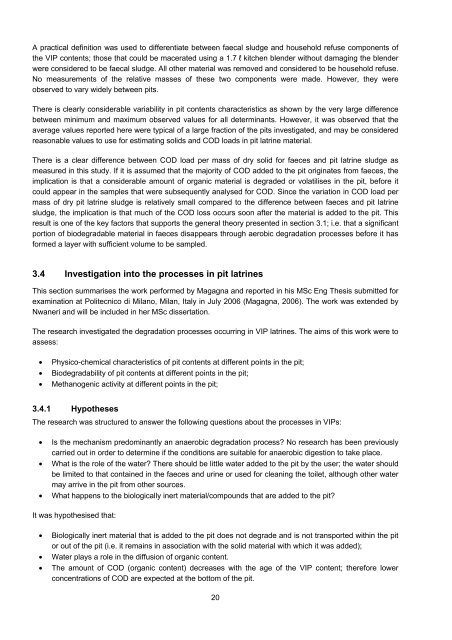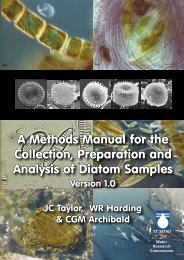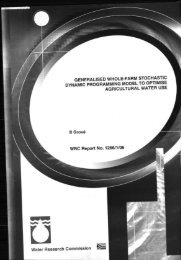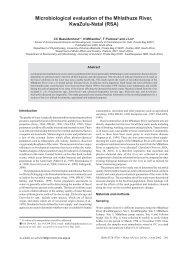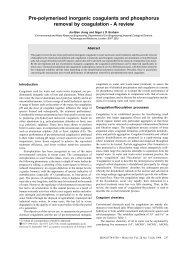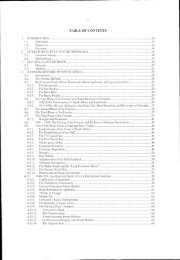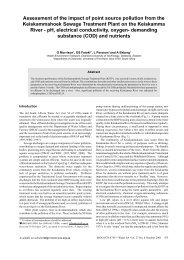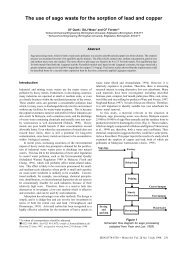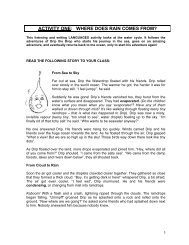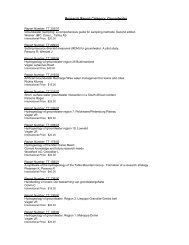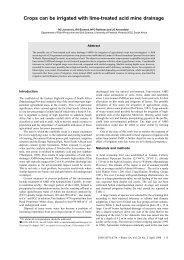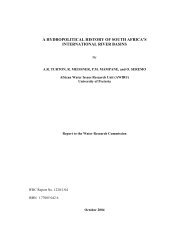and the Efficacy of Pit Latrine Additives - Water Research Commission
and the Efficacy of Pit Latrine Additives - Water Research Commission
and the Efficacy of Pit Latrine Additives - Water Research Commission
- No tags were found...
You also want an ePaper? Increase the reach of your titles
YUMPU automatically turns print PDFs into web optimized ePapers that Google loves.
A practical definition was used to differentiate between faecal sludge <strong>and</strong> household refuse components <strong>of</strong><br />
<strong>the</strong> VIP contents; those that could be macerated using a 1.7 l kitchen blender without damaging <strong>the</strong> blender<br />
were considered to be faecal sludge. All o<strong>the</strong>r material was removed <strong>and</strong> considered to be household refuse.<br />
No measurements <strong>of</strong> <strong>the</strong> relative masses <strong>of</strong> <strong>the</strong>se two components were made. However, <strong>the</strong>y were<br />
observed to vary widely between pits.<br />
There is clearly considerable variability in pit contents characteristics as shown by <strong>the</strong> very large difference<br />
between minimum <strong>and</strong> maximum observed values for all determinants. However, it was observed that <strong>the</strong><br />
average values reported here were typical <strong>of</strong> a large fraction <strong>of</strong> <strong>the</strong> pits investigated, <strong>and</strong> may be considered<br />
reasonable values to use for estimating solids <strong>and</strong> COD loads in pit latrine material.<br />
There is a clear difference between COD load per mass <strong>of</strong> dry solid for faeces <strong>and</strong> pit latrine sludge as<br />
measured in this study. If it is assumed that <strong>the</strong> majority <strong>of</strong> COD added to <strong>the</strong> pit originates from faeces, <strong>the</strong><br />
implication is that a considerable amount <strong>of</strong> organic material is degraded or volatilises in <strong>the</strong> pit, before it<br />
could appear in <strong>the</strong> samples that were subsequently analysed for COD. Since <strong>the</strong> variation in COD load per<br />
mass <strong>of</strong> dry pit latrine sludge is relatively small compared to <strong>the</strong> difference between faeces <strong>and</strong> pit latrine<br />
sludge, <strong>the</strong> implication is that much <strong>of</strong> <strong>the</strong> COD loss occurs soon after <strong>the</strong> material is added to <strong>the</strong> pit. This<br />
result is one <strong>of</strong> <strong>the</strong> key factors that supports <strong>the</strong> general <strong>the</strong>ory presented in section 3.1; i.e. that a significant<br />
portion <strong>of</strong> biodegradable material in faeces disappears through aerobic degradation processes before it has<br />
formed a layer with sufficient volume to be sampled.<br />
3.4 Investigation into <strong>the</strong> processes in pit latrines<br />
This section summarises <strong>the</strong> work performed by Magagna <strong>and</strong> reported in his MSc Eng Thesis submitted for<br />
examination at Politecnico di Milano, Milan, Italy in July 2006 (Magagna, 2006). The work was extended by<br />
Nwaneri <strong>and</strong> will be included in her MSc dissertation.<br />
The research investigated <strong>the</strong> degradation processes occurring in VIP latrines. The aims <strong>of</strong> this work were to<br />
assess:<br />
<br />
<br />
<br />
Physico-chemical characteristics <strong>of</strong> pit contents at different points in <strong>the</strong> pit;<br />
Biodegradability <strong>of</strong> pit contents at different points in <strong>the</strong> pit;<br />
Methanogenic activity at different points in <strong>the</strong> pit;<br />
3.4.1 Hypo<strong>the</strong>ses<br />
The research was structured to answer <strong>the</strong> following questions about <strong>the</strong> processes in VIPs:<br />
<br />
<br />
<br />
Is <strong>the</strong> mechanism predominantly an anaerobic degradation process No research has been previously<br />
carried out in order to determine if <strong>the</strong> conditions are suitable for anaerobic digestion to take place.<br />
What is <strong>the</strong> role <strong>of</strong> <strong>the</strong> water There should be little water added to <strong>the</strong> pit by <strong>the</strong> user; <strong>the</strong> water should<br />
be limited to that contained in <strong>the</strong> faeces <strong>and</strong> urine or used for cleaning <strong>the</strong> toilet, although o<strong>the</strong>r water<br />
may arrive in <strong>the</strong> pit from o<strong>the</strong>r sources.<br />
What happens to <strong>the</strong> biologically inert material/compounds that are added to <strong>the</strong> pit<br />
It was hypo<strong>the</strong>sised that:<br />
<br />
<br />
<br />
Biologically inert material that is added to <strong>the</strong> pit does not degrade <strong>and</strong> is not transported within <strong>the</strong> pit<br />
or out <strong>of</strong> <strong>the</strong> pit (i.e. it remains in association with <strong>the</strong> solid material with which it was added);<br />
<strong>Water</strong> plays a role in <strong>the</strong> diffusion <strong>of</strong> organic content.<br />
The amount <strong>of</strong> COD (organic content) decreases with <strong>the</strong> age <strong>of</strong> <strong>the</strong> VIP content; <strong>the</strong>refore lower<br />
concentrations <strong>of</strong> COD are expected at <strong>the</strong> bottom <strong>of</strong> <strong>the</strong> pit.<br />
20


